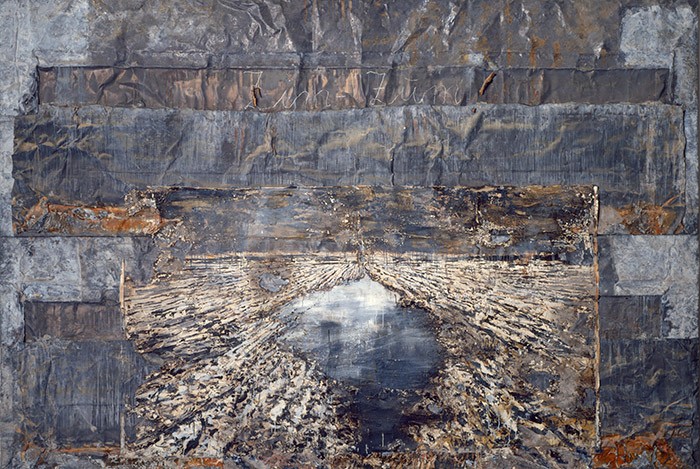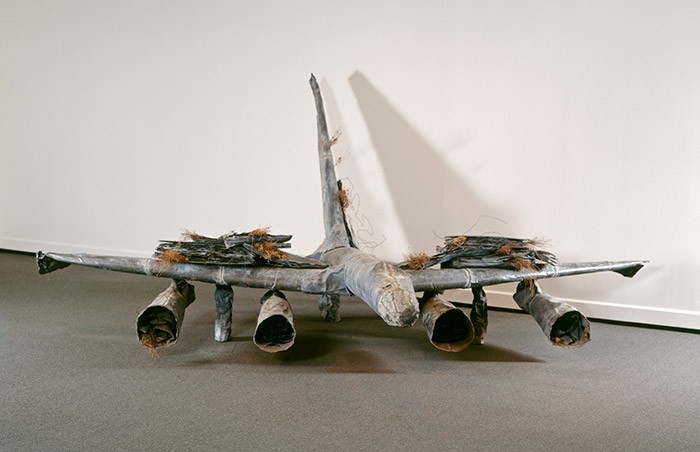Anselm Kiefer, Zim Zum, 1990, acrylic, emulsion, crayon, shellac, ashes, and canvas on lead, National Gallery of Art, Washington, Gift of the Collectors Committee, 1990.82.1
Coming to Terms with the Past
Grade Level: 9–12 Curriculum Connections: History/Social Studies
Students will examine the work of German artist Anselm Kiefer and discuss how art might be a means of understanding and coming to terms with history. Students will follow in Kiefer’s practice by creating their own works of art that address events from American history.
Anselm Kiefer, Angel of History, 1989, lead, glass, and poppies, National Gallery of Art, Washington, Eugene L. and Marie-Louise Garbáty Fund, 1994.75.1
Discussion
- What types of materials appear to be used in these works?
- What feeling do these two works give you?
- Are there any details in these works that might give you a sense of time or place, and when or where they were created?
Background
“I like vanished things . . . because I like things that are ruined. That’s a starting point for me.” —Anselm Kiefer
Anselm Kiefer was born in Germany and studied law before turning to art. In 1969, Kiefer produced performances in which he was photographed in several European cities giving a Nazi-style salute. Kiefer wanted to confront the Nazi past and look at the historical processes in German culture, myth, and history that made it possible.
Angel of History, which is made of lead, glass, and poppies, draws on the Greek myth of Icarus, who aspires to reach the heavens but is fated to fail. The airplane, made of lead, is doomed in its construction so that no flight would be possible. Poppies, a symbol of memory in certain ancient myths, are tucked between lead books—representing the weight and legacy of history. This artwork draws influence from the writings of philosopher Walter Benjamin, specifically his Theses on the Philosophy of History.
Kiefer’s Zim Zum weighs close to one thousand pounds and is constructed of lead sheets that have been burned and corroded. Over them Kiefer applied acrylic paint, ashes, and other materials. At the bottom he affixed a separate landscape painting (depicting a lake) on a tattered canvas. The title Zim Zum, scrawled in childish script across the top of the work, refers to the concept of tsimtsum, described in the mystical and esoteric interpretation of Judaic scripture, the Kabbalah. Tsimtsum is a divine contraction of God, likened to a breath. It made possible the emanation that was the instant creation of the universe, but it also admitted the possibility of evil. Kiefer’s works attempt to confront the nature of evil and, specifically, the evil of the Holocaust, the memory of which he invokes through his materials and pictorial references to German architecture and the German woodland.
Activity
For many artists, their materials, working methods, and intended meanings are inextricably bound. Anselm Kiefer, for example, has devoted much of his work to themes in German history, exploring myths of national identity and the Holocaust. Some of Kiefer’s materials, such as lead, have particular significance in Germany—for example, the tradition of Bleigiessen involves families melting small bits of lead over a candle on New Year’s Eve, then pouring the molten lead into cold water to take shape. The shape that the lead forms is said to reveal something about what the future will hold.
Anselm Kiefer has been both praised and reproached for his use of German icons and themes as vehicles for Vergangenheitsbewältigung, or “coming to terms with the past.” Have students continue their exploration of materials by asking them to identify a set of materials that would reflect some dark chapter in American history—for example, the treatment of American Indians by European settlers, slavery, or the internment of Japanese Americans during World War II. If those materials were used in the making of art, what ethical considerations might come up? Once those considerations are discussed, then have students develop a work of art that addresses the historical moment on which they have chosen to focus. What techniques and materials will they use, and how would the piece be displayed?
Extension
Have students read and discuss the poem “Lead, Glass, and Poppy” by American poet Kristin Prevallet, which is inspired by Kiefer’s sculpture. Students may wish to write poetry in response to their peers’ artworks.
Regarding her poem, the poet says,
Lead, glass, and poppy are the materials Kiefer used in many of his paintings, and I was particularly inspired by how these materials worked to create the vatic yet charred landscapes of his paintings—to me, they evoke what has been—and what will always be—left behind when the bodies and buildings (rubble and “collateral damage”) have been cleared during and after war. Is the past being constructed on the pages of the newspaper, right before my eyes? What future is being foreseen? What is revealed by the layers of meaning that get tossed into the trash at the end of the day? Instead of burning the newspapers, I sought to bring them into a new form where the “news” could be understood in a completely different way.
National Core Arts Standards
VA:Cn11.1.HSI Describe how knowledge of culture, traditions, and history may influence personal responses to art
VA:Pr6.1.HSII Make, explain, and justify connections between artists or artwork and social, cultural, and political history
VA:Re7.1.HSI Hypothesize ways in which art influences perception and understanding of human experiences
VA:Re8.1.HSI Interpret an artwork or collection of works, supported by relevant and sufficient evidence found in the work and its various contexts
Download or borrow the Art Since 1950 teaching packet
Borrow the 20th-Century American Art DVD
Play the NGAKids Paintbox interactive
Play the NGAKids Photo Op interactive



